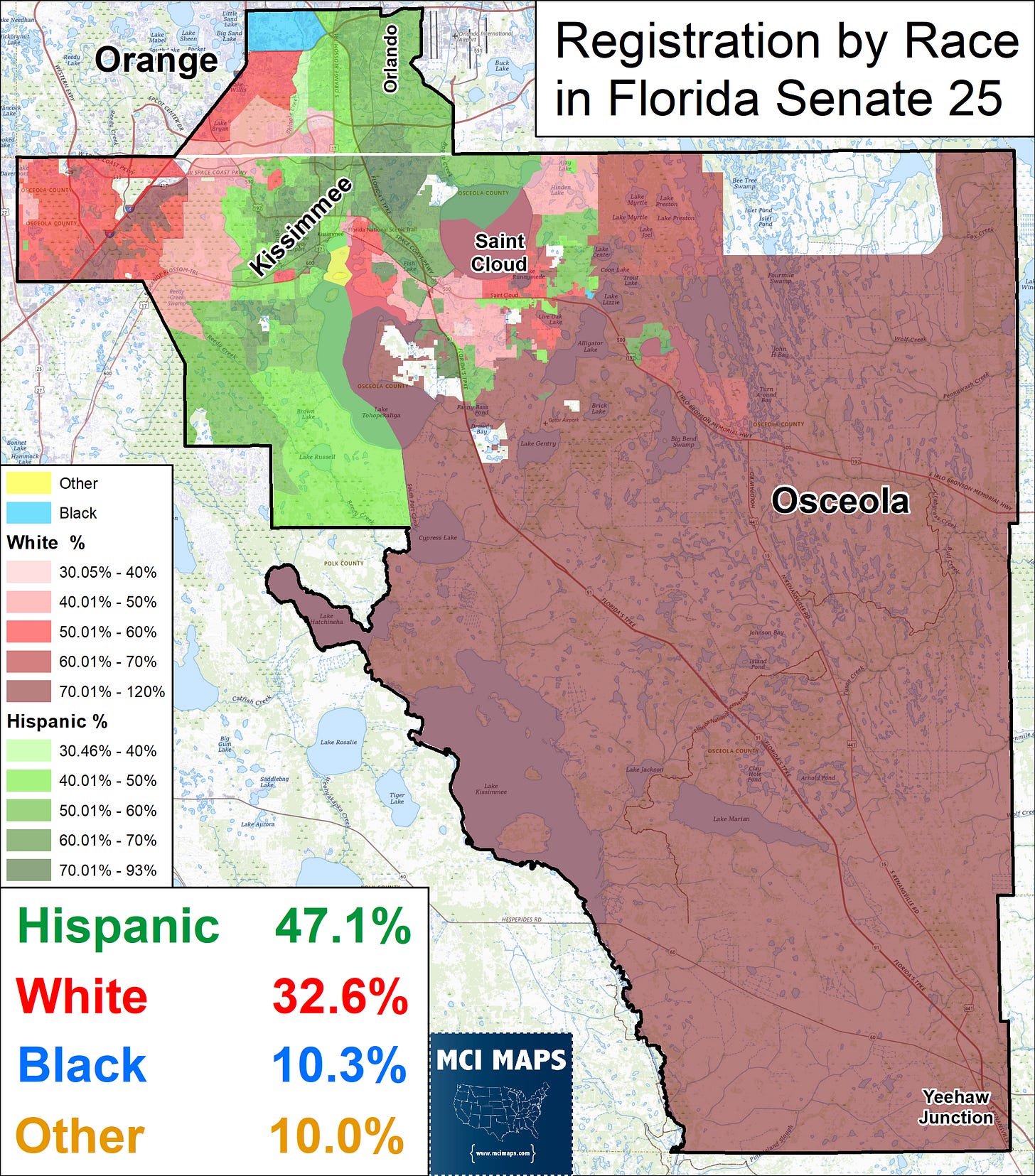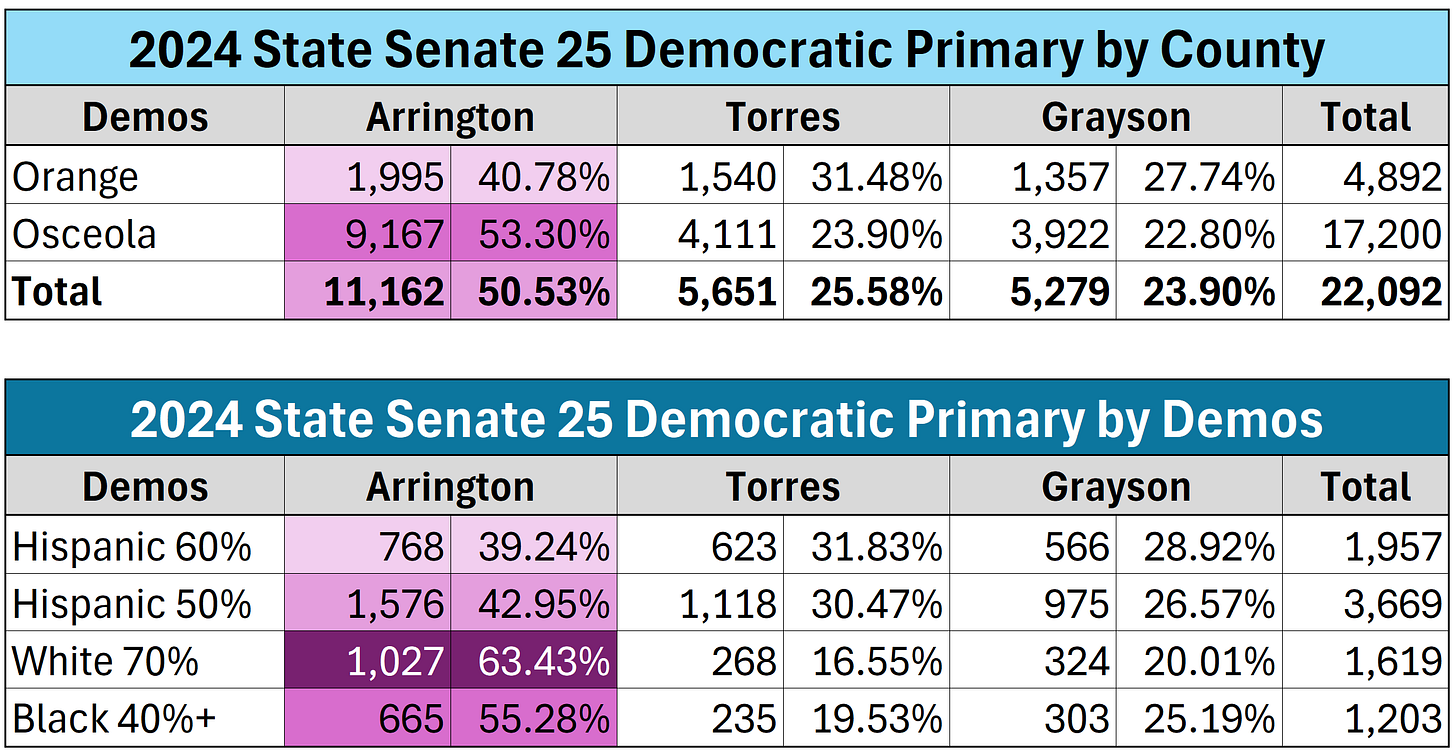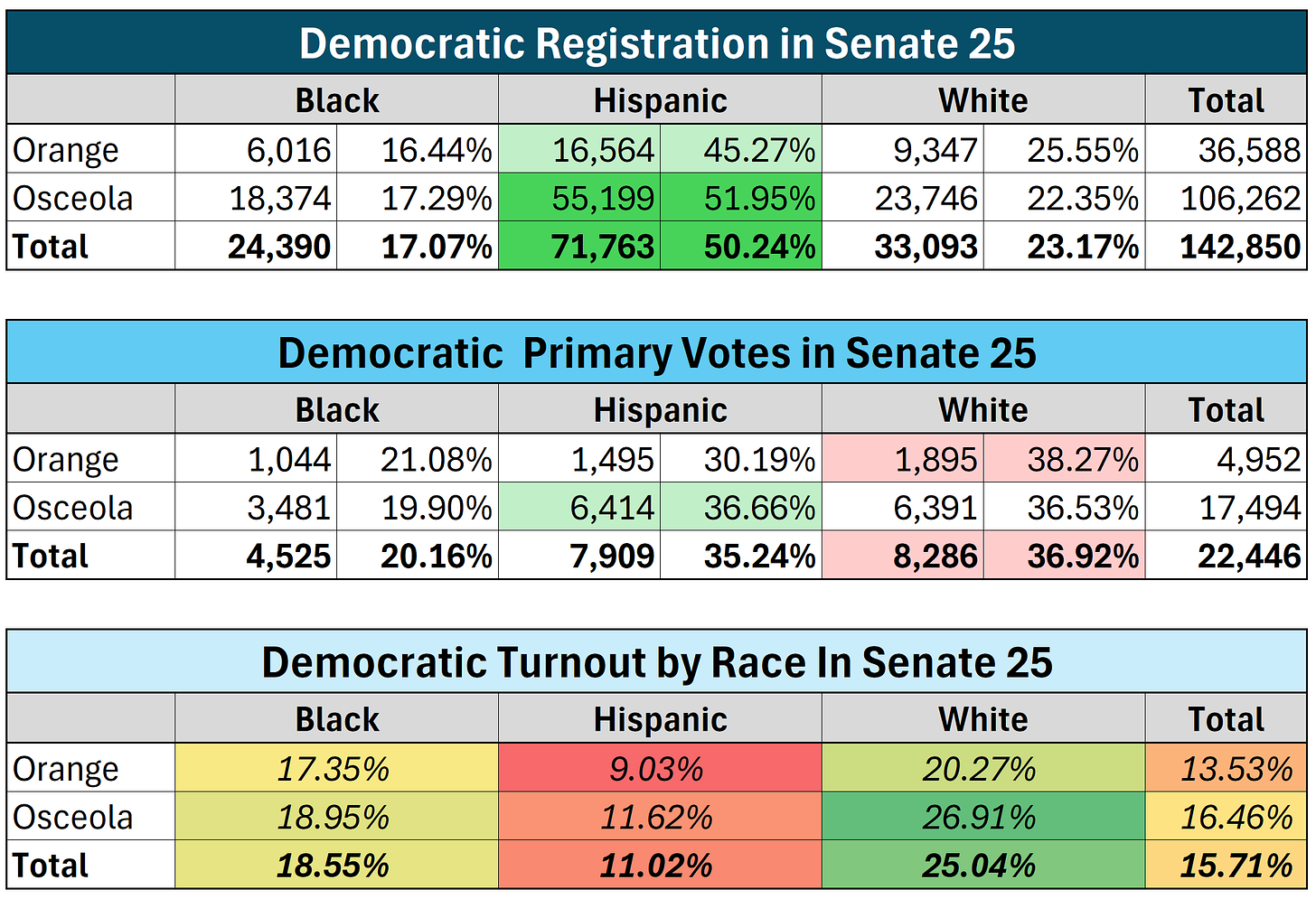Issue #241: Florida Senate District 25: Racial vs Geographic Representation
Hispanic representation in Central Florida
Last year, Hispanic-Majority Florida State Senate District 25 was the home to a heavily contested primary and closer-than-expected general election. The district covers all of Osceola county and a portion of Orange; drawn to give Hispanic voters a chance to elect a candidate of their choosing. Hispanic voters make up 47% of the registration in the district, with the heavily Puerto Rican Kissimmee community located right in its heart. Much of the population lies on the west end of the seat, with Southeastern Osceola being sparsely-populated
In 2024, with incumbent Senator Victor Torres termed out, a Democratic Primary saw the issue of representation come to the forefront. In that race, the debate over Hispanic Representation vs Osceola County representation became a major dividing point for voters. Then, what was historically a heavily-Democratic seat saw major shifts to the right that November, leading to a much closer election than expected. The final result saw Kristen Arrington, a white democrat, win the seat with Hispanic voter support.
At the heart of the issue for both campaigns was the desire of Hispanic voters in the district and their representation in the legislature. Does the winner need to be Hispanic? Did Hispanic voters have a candidate of strong preference? This article will look at both the primary and general; diving into the complex issues of racial representation and redistricting.
Hispanic Growth and Redistricting
Since 2012, Central Florida has had a state senate district that is drawn to give its growing Hispanic community a voice in the legislature. The growth of Hispanic voters in the Orlando area, namely those of Puerto Rican nationality, has been well documented. I covered part of this growth in my 2020 article on politics in the “I-4 Corridor.” The region has seen massive Puerto Rican migration, with a combination of folks coming from the island itself or the New York City area. As a result, counties like Osceola went from being 29% Hispanic in 2000 to 56% Hispanic by 2010.
The demographic changes made themselves felt in redistricting with the 2012 re-map process. That year, State Senate District 14 was drawn to unite the Hispanic communities of Orange, Osceola, and Polk. It easily elected Puerto Rican State House member Darren Soto to the seat. Soto faced no Democratic primary and easily prevailed in the deep-blue seat. The seat then drawn was 47% Hispanic.
In 2015 and 2016, the Florida legislature was embroiled in a court-ordered redraw of their State Senate districts. The result was a major remap. While the map created a historic 4th Hispanic-majority State Senate seat in Miami-Dade, the remap also shrunk the Hispanic-access SD14. The district was reshaped to be all of Osceola and part of Orange. Renumbered Senate District 15, the seat was 35% Hispanic. The drop was controversial, while legislators pointed out the district in 2012 had not been majority-Hispanic in voting either. However, this shrunk the power of Hispanic voters in a seat, putting their influence at risk.
In 2016, Darren Soto left to the Senate to run for Congress. Hispanic Democrats rallied around Orange County State Rep Victor Torres, who won the democratic primary against a white opponent with 57% of the vote; winning with strong Hispanic vote shares and a solid amount of support from white voters. In the safe blue seat, Torres had no trouble that November. Despite the questionable redraw, the seat remained with the candidate Hispanic voters wanted.
Heading into 2022, the Senate map for Orlando was pretty easy to foresee. With further demographic changes, namely massive growth in Osceola County, drawing a majority-Hispanic seat would be easy. Worries about GOP gerrymandering were well-founded, but it was widely believed they wouldn’t dare mess with Hispanic representation in Central Florida. Before the first drafts came out, I predicted a seat that would be all of Osceola and some of the Hispanic parts of Orange, making for an easily Hispanic-Majority seat. My prediction map is pretty close to reality.
Torres would continue to hold the seat until he was termed out in 2024. That retirement would trigger a race that tested the issue of racial representation.
The Democratic Primary Race
With Victor Torres termed out, it was always possible several major candidates would enter the fray. The Orlando and Osceola region has no shortage of Democratic officials looking to rise higher in the political ladder. However, rather than becoming a 5-person crowded primary, the field quickly settled on two major heavyweights that blocked out the chances for anyone else of note to make a run. From late 2023 and onward, the Democratic Primary was a two-person affair between State Representative State Representative Kristen Arrington and Carmen Torres, the wife of the outgoing senator.
Both Torres and Arrington has access to money and strong appeal with different voters in the district. Their contest quickly became a battle of ethnicity vs geography.
Race vs Geography
From the beginning, Carmen Torres framed herself as the candidate of her husband’s legacy and candidate for the district’s Hispanic population. Torres, to her credit, was not just Vic’s wife. She was heavily involved in Orange County Government and politics for many years. She had strong ties with unions and regional democratic leaders, allowing her to raise a solid sum of money. Her ties, like her husbands’, were strongest in the Orange County portion of the district. Her and Vic’s daughter, Amy Mercado, was elected the Orange County Property Appraiser in 2020; four year’s after she’d won her father’s state house seat in 2016.
Torres would make Hispanic representation a key issue in the campaign. In interviews with the local press, Torres made a direct point about continuing Hispanic representation for the seat.
“There’s at least 6 million Hispanics in the state of Florida, and 1.2 million of those are Puerto Rican, and you only have one Puerto Rican Hispanic in the Senate,” Torres said of her husband, who is leaving because of term limits. “It just blows my mind. To not have representation would be a travesty.”
Hispanic representation in the legislature would become a major point for Torres as the campaign went on. She would directly argue that not nominating her risked the seat falling into Republican hands. She noted both Republican candidates running were Hispanic.
“If we lose the primary to either of my two opponents, we will lose the seat to a Republican Hispanic. I know how my people vote, okay?”
Torres laid out a very clear gauntlet, arguing that she, as the lone Hispanic candidate, was the rightful air to the seat. Her main opponent would make a similar argument about representation, but with a geographic bent rather than a racial bent.
The financial frontrunner for the seat was State Representative Kristen Arrington, who was elected to the majority-Hispanic HD43 in 2020. Arrington, who is white, won her 2020 primary with 30% in a very crowded race. However, she faced no primary challenge in 2022 in the Hispanic-majority HD46 and won her general elections with no problem. While not Hispanic, she had built a base of Hispanic support.
Arrington, who is married to Osceola commissioner Brandon Arrington, argued that it was time for an Osceola politician to hold the seat; as both the Torres’ come from the Orange County side of the district.
“I’m an Osceola girl,” Arrington said. “Went to elementary, middle, high school, college, and even started my own business in Osceola. … I think a lot of us across the board are excited about the opportunity for Osceola to be able to have a seat at the table.”
Arrington’s family ties to Osceola don’t end with her husband. Her mother in law is Mary Jane Arrington, the longtime elections supervisor for the county.
The race between Arrington and Torres hence set up a fight over ethnic vs geographic representation. Arrington clearly aimed to cut through racial lines and instead advocated for Osceola’s turn in representing the seat. This was a strong strategy, as Osceola was likely to make up 3/4 of the likely primary vote. In addition, it was very unlikely Hispanic support along could secure Torres a victory. Democratic registration gave Hispanics 52% of the vote. However, turnout dynamics often saw Hispanic and White voters close together with a plurality each. The 2022 primary was 37% white and 35% Hispanic; a product of white turnout being 32% to Hispanic 14%. That kind of turnout dynamic is common in the area.
Hispanic voters lag behind both Black and white Democrats consistently in elections. For Torres, a key part of winning would need to involve boosting Hispanic turnout. This was seen back in 2016, when Darren Soto’s Congressional bid saw Hispanic turnout jump in that year’s primary.
Heading into the summer, the geography vs race primary was all set. However, just as qualifying was wrapping up, a major shakeup occurred in the race.
Alan Grayson Returns
In June, the race saw a major shakeup when former Congressman Alan Grayson announced he was running for the State Senate seat. Grayson, who’s career is so vast and controversial that I wrote a FIVE PART SERIES ON HIM last year, was running for the US Senate initially. By this point in his career, Grayson was a perennial candidate, seeming to jump from race to race as he sought to rebuild his shattered political career.
Grayson had most recently lost a Democratic Primary to Maxwell Frost in Congressional District 10 and back in 2018 had unsuccessfully primaried Darren Soto in the 9th Congressional. In his announcement, Grayson stated the reason for the change in plans was the inability to raise the needed funds for a statewide bid. Independently wealthy, Grayson can self-fund, and stated “The needs of a state Senate campaign are the lowest I’ve ever faced.”
In theory Grayson’s entrance could have hurt Arrington, splitting the non-Hispanic vote. However, he also had batches of support across ethnic lines. However, he was, as I saw it, never a risk to win the primary due to his many years of scandals. His self-funding would be the big hiccup, especially if he got angry at one of his opponents and trained his fire on them.
The Campaign
With the now-three-way contest, a large chunk of money was spent on the contest. Grayson has self-funded his campaign with $240,000. Carmen Torres raised $120,000 and has another $40,000 from the “Latino Rising” committee. Arrington has raised over $200,000 and raised another $300,000 through a political committee! Meanwhile, negative mailers ramped up from 3rd party groups in the last few weeks. Arrington was seen as the clear frontrunner - not just with the most money but also the most third-party support.
A poll from the beginning of August showed Arrington with the lead with 38%; with Torres at 15% and Grayson at 20%. At the time the poll showed Arrington had the highest name-ID. This was a very bad poll for Torres, but it was noted that polling back in the 2016 Soto race under-estimated his support as well. The big question was if Hispanic voters would consolidate around Torres, and how their turnout would be. Otherwise it was believe Arrington was the destined winner of the primary.
Primary Results and Analysis
When the results began to come in on election night, it was clear almost instantly that Arrington was the winner. When all votes came in, Arrington had 51% of the vote, outpacing Torres and Grayson combined.
Arrington’s win cut across racial lines. She won Black, Hispanic, and white voters. Torres was strongest in Hispanic communities, often doing very poor with Osceola’s rural white population. Grayson was strongest in that very rural community, also doing stronger in the Orange County portion of the district.
A more detailed map, with the demographics of the primary vote, can be seen below.
Arrington’s argument for Osceola representation clearly worked. She secured 53% of the vote in Osceola, well ahead of her plurality win in Orange County. Notably, while Arrington was strongest in the heavily white precincts of the district, she also had the largest vote share in Hispanic-majority communities as well. The demographic table below relies on precinct data.
We don’t have any massive 90%+ Hispanic precincts in the district to compare, but its clear Torres and Arrington split the Hispanic vote. While Torres did strongest with Hispanics, she was unable to consolidate that voting block the same way Darren Soto or Vic Torres did.
Had Torres consolidated the Hispanic vote, it would not have been enough to secure victory. Hispanic voters narrowly lost out to whites in votes cast. This was thanks to a horrendous 11% Hispanic turnout vs 25% for white democrats. In Torres’ home base of Orange, it was just 9% vs the 12% in Osceola.
Torres was unable to bring Hispanic voters out or unite them around her candidacy. Arrington, meanwhile, became the candidate for most voters regardless of demographics. Her stronger performance in Osceola, despite it being more Hispanic than Orange, further showed her argument for county representation carried more weight with voters than ethnic representation did.
The General Election
The results of the primary put Arrington into a general election with Republican candidate Jose Martinez. A lower-financed GOP primary saw Martinez, a businessman, defeat controversial Osceola School Board member Jon Arguello. This meant a general election in a majority-Hispanic seat between a Hispanic Republican and a white Democrat. Martinez did make nationality an issues; namely saying the district deserved someone who could speak Spanish.
“I think we deserve a representative who can at least speak the language,”
Initially, all sides viewed the Senate 25 as a very likely to safe Democratic seat. Arrington was a strong candidate and clearly had solid Hispanic support in the Democratic primary. It may have been another matter had Arrington won while being crushed in Hispanic communities; but that did not happen. The district had voted for Joe Biden by 18% in 2020.
However, Democrats did have their eye on it due to results from 2022. As I documented in this article, SD25 had actually narrowly voted for Ron DeSantis in 2022 as Torres only won re-election by 6%. However, this has been due to a massive turnout disparity - notably white turnout being 2x as high as Hispanics. At the time the seat was 48% Hispanic and 32% white in registration. The actual vote cast was 46% white and 35% Hispanic; with Republican turnout being 16 points higher than Democrats.
Democrats worked to make sure the turnout disparity of 2022 did not repeat itself in Senate 25. These efforts worked, as Democratic turnout would only narrowly trail Republicans in the district. While Hispanic turnout still lagged white voters, it was FAR better than the 2022 nightmare, leading to a vote cast that was 43% Hispanic and 37% white.
With that turnout dynamic, there should have been nothing to worry about with Senate District 25. However, we know that was not the case.
The Massive Hispanic Swing
As has been so well documented across countless right-ups, the Hispanic vote in Florida and nationwide swung much further to the right. Donald Trump would flip Osceola County, a place he’d lost by 30 points back in 2016 to Hillary Clinton. It was the Osceola results on election night that gave me my first alarm that the election was not going to be an easy Harris win. The swing in the Osceola region was dramatic that it was the first post-election analysis I did. You can read all the details here.
Why did these swings happen? Well I touched on it in the Osceola piece, but I also went much more into it in another article from that same time. As I laid out in great detail in this article, economic concerns drove the vote swing more than anything else. Broad macro-economics in America were good, but inflation and cost of living issues weighed heavily on working class voters and especially in Hispanic communities; which often have larger households. The swing with Hispanics flipped Miami-Dade and Osceola County to the GOP.
State Senate Results
Arrington did manage to hold on, carrying the district by 3%. Like many top-line Democrats, she lost Osceola County, albeit by less than 1%. Her margin in Orange County secured victory. She performed very similar to the top of the ticket, with her win being just higher than Harris’ 2.7% win.
Back in the primary, Carmen Torres has pontificated that Arrington as the nominee risked the seat going to GOP hands. However, it does not appear Arrington was punished by Hispanics any more than Democrats broadly were. Looking at the voter precincts with the largest Hispanic populations (few were over 70%) - we see Arrington won these precincts by similar and stronger margins than President or US Senate.
Darren Soto’s strong performance in the 9th Congressional does show his stronger appeal. This is not just attributed to Soto’s nationality, but also his strong community outreach in the district. Perhaps Torres would have ended up higher than Arrington, but that is no guarantee. Soto’s cross-over appeal is something earned over many years.
Arrington’s narrower-than-expected-win cannot be attributed to her being white, or her being a weak candidate. Conversely, the fact she did as good as other Democrats while against a Hispanic candidate show that she was strong; holding her ground with the rest of the democratic slate. Hispanic defections to Martinez were the same folks who defected to Trump or Rick Scott. Therefore, it does not seem Arrington was hurt by not being Hispanic.
Final Thoughts
Even before the general election, the results of the primary made Senate District 25 a race I knew I would eventually write about. Arrington’s campaign successful cut past ethnic lines, earning support across many demographics. Her focus on the community of Osceola as a whole proved to be very successful and showed that voters are more than willing to cross ethnic lines when a candidate is of their liking.











